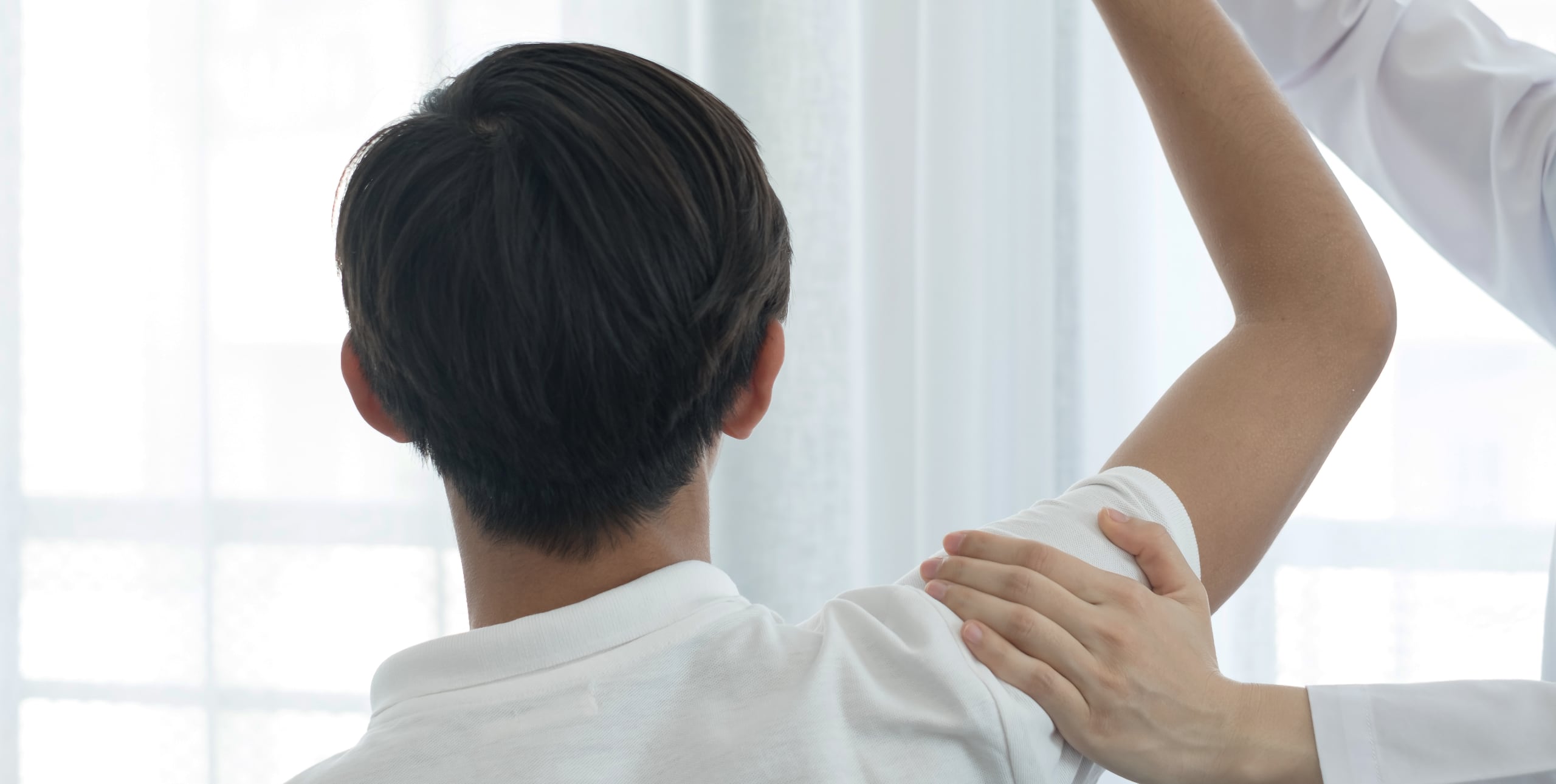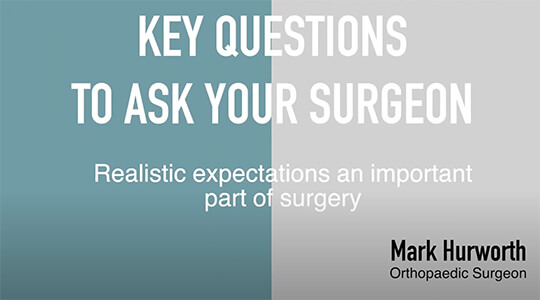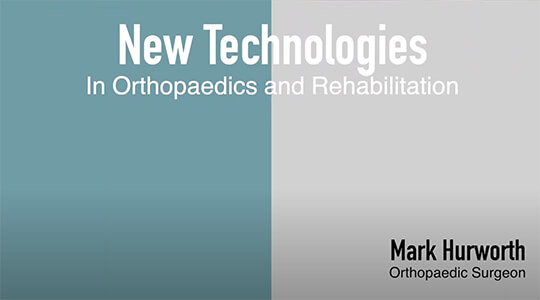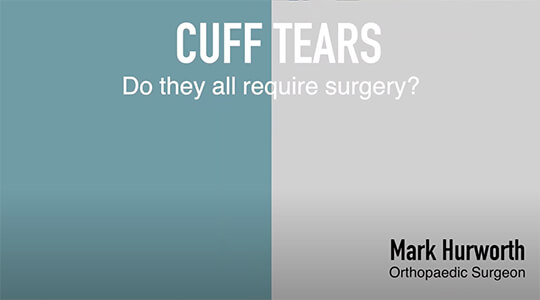Rotator cuff Perth
Best treatment for rotator cuff injuries
A rotator cuff tear can seriously impact your daily life, causing pain and discomfort, but also reducing your mobility and strength. Below we go over the essential facts and some additional background information about the types of rotator cuff injuries, the best treatment options and the big questions: do I need surgery, and when will I get back to normal?

My orthopaedic practice in a nutshell
Rotator cuff injury
What is a rotator cuff injury? Do I need surgery?
Your rotator cuff is a combination of 4 muscles and tendons in the shoulder. They keep the ball (the head of the humerus) in your shoulder socket (glenoid). This mechanism allows us to raise or rotate an arm. The most commonly injured tendon is the supraspinatus, as it travels through the tightest part of the shoulder. With a rotator cuff injury, moving becomes painful or even impossible and that is when you may be referred to a shoulder surgeon to discuss surgery.
We commonly classify these rotator cuff tears as:
- Traumatic: You would know exactly at what moment in time the symptoms started, after a specific incident or injury often involving significant force.
- Atraumatic: In these cases, the symptoms gradually appear over time and you wouldn’t have a clear memory of the moment your symptoms started.
Why are these categories important? When there is trauma, we are more likely to perform certain investigations earlier. For example, an MRI scan would tend to be requested earlier after trauma.

Mr Mark Hurworth, Shoulder surgeon Perth
It is important to understand that atraumatic rotator cuff tears are very common as you get older. The decision to have surgery or not is often a complex conversation and as a shoulder surgeon, I am cautious about embarking on surgery in atraumatic shoulder conditions. It is sometimes acceptable to treat atraumatic rotator cuff tears without surgery as you get older, as other muscles in the shoulder (the deltoid in particular) will compensate. Not everything that is broken needs to be fixed, can be fixed or is worth fixing.
Patients in Perth who have come to see me for a shoulder problem know that I take this transparent approach and they appreciate that a surgeon doesn’t automatically sign them up for surgery without questioning the pros and cons.
In particular, the questions I would ask are:
- How bad are your symptoms? Typically I see you after you have had symptoms for a while, so are they improving or getting worse?
- Have you tried reasonable non-operative treatment, such as physiotherapy and injections – especially with atraumatic conditions?
- Can it be fixed?– how big is the tear and is it associated with muscle wasting (a major predictor of re-tearing or inability to fix)
- How long does recovery take? – typically with cuff repairs you may be in a sling for six weeks, struggle with movement for another six weeks, and feel that the whole rehabilitation takes six months or longer
- What are the chances of a tear happening again?Risk factors are: smoking, age, size of the tear and associated retraction and atrophy of muscle and quality of tissue (“old rope” is difficult to fix).
Rotator cuff tear
How do I know I have a rotator cuff tear?
To put it simply: if you have injured your shoulder and you cannot move your arm, it is wise to get an ultrasound and/or MRI as soon as possible. We call this inability to move the arm “pseudoparalysis”, and typically it would be associated with an acute musculotendinous injury.
If the onset of symptoms such as pain and weakness has come on over time without an obvious injury, it could be considered a “normal age-related” tear of your rotator cuff tendons. Statistics tell us that people in their 70’s commonly get those tears: up to 1 in 5 has a full-thickness rotator cuff tear without knowing it or experiencing any symptoms (a much higher percentage for partial-thickness tearing). It confirms that there is no reason to have a one-size-fits-all approach and that everything depends on your symptoms and how well you can manage them without surgical intervention.
So what would symptoms from a tear look like? Typically you feel pain when you reach overhead, and the pain radiates down your arm. You could feel pain when you bring your hand behind your back. Other patients tell me the shoulder interrupts their sleep.
Pain radiation or referral is a confusing phenomenon: the pain from the shoulder typically radiates down your arm and, sometimes after a while, up into your neck. The muscles behind your shoulder blade can become very sore, especially the trapezius and the muscles around the back of the shoulder blade. Female patients in particular can get associated feelings of numbness in the arm and hand.
Story continues below video gallery
Videos about shoulder conditions and surgeries
Rotator cuff treatment
Can I avoid surgery?
If you ask that question to ten shoulder surgeons, chances are that you will get a lot of different opinions, not just about whether surgery is a good idea, but about what type of surgery. This is a bit disconcerting for patients, and understanding your condition and the source of your pain is the first step towards managing things well.

Mr Mark Hurworth, Shoulder surgeon Perth
“It is not uncommon for me to tell patients that they can and should avoid surgery“
If a rotator cuff tear is causing symptoms that have appeared gradually and are manageable, then we will likely consider nonoperative treatment. If you are over 65, surgery can often safely be avoided with atraumatic tears. If you are younger, and you have a full-thickness rotator cuff tear, then surgery may give a better result.
So if I want to avoid shoulder surgery, what type of alternative treatment is available for rotator cuff tearing?
- Steroid injections – if they are done in the right place – may sometimes give you a dramatic and lasting improvement in symptoms, typically if there is associated inflammation bursitis.
- Exercise – motion is an essential part of the treatment for any joint problem. If you stop moving your shoulder, you will typically have more trouble. This is simple mechanics – without motion the joint gets stiff, and the muscles waste away.
- Activity modification – It may take some reflection to work out the movements that trigger pain, then avoid only those. Keep moving your shoulder in other ways, avoiding only these specific movements. This will often helps resolve symptoms over time.
- Anti-inflammatory medication and other simple analgesia like Panadol Osteo can be very effective, especially if you are having trouble sleeping.

Mr Mark Hurworth, Shoulder surgeon Perth
“This ties in with the strong focus on home exercise we have at our shoulder clinic in Perth. We are looking to introduce innovative new equipment, based on a product we are now using in clinical trials.”
If you have a really large cuff tear that does not look repairable, a shoulder arthroscopy may still be advised to reduce some of the symptoms, particularly relating to the long head of the biceps (LHB). We often call the LHB the “appendix of the shoulder” because it causes a lot of trouble and is not missed when it is removed, in the vast majority of patients.

Rotator cuff repair Perth
Arthroscopic rotator cuff repair
Generally, I do more than 90% of my shoulders arthroscopically as day surgery cases, ie the repair is conducted through 2 or 3 small incisions, using a telescope. This makes things more comfortable after surgery for the patient, as the deltoid muscle is not injured in the same way as an “open” repair.
In addition, the use of nerve blocks has revolutionised shoulder surgery in the last 20 years, ie typically you will have a light general anaesthetic and a nerve block that will numb the whole arm for around 12 hours. This can be a bit of a shock when you wake up, so speak to your anaesthetist about it when you see him or her.
Recovery after surgery is often what people find most bothersome, ie having to wear a sling for up to six weeks. Sleeping is always a problem for the first few nights – a lot of people will initially sleep in recliner chairs to get used to the sling.
Preparing for rotator cuff surgery
How do I prepare? And what about recovery?
My patients in Perth know that I keep repeating this: keep moving. There are restrictions of course which we will clarify before and after surgery, but at the same time we encourage you to keep using your shoulder.
Recovery depends a lot on your motivation. Some of my patients have terrible tendons, and they recover extremely well because they take the exercises seriously. If you become passive and stop moving after your injury or after surgery, you can get trapped in a downward spiral.
The downwards spiral of a poor result after a shoulder injury or surgery often involves:
- Not moving, and the associated stiffness and loss of muscle tone and strength
- Sleeplessness
- Taking addictive medications – opiate medication in particular. It is important to remember that opiate medication such as Palexia (Tapentadol) is highly addictive, and if you take it for longer than a few weeks there is evidence to suggest that it may make your problems worse not better.
To break this cycle will often involve an act of will on the part of the patient with the help of friends and family, not further surgery.
Proper rehabilitation after injury or surgery, by contrast, involves:
- Getting the shoulder moving with appropriate exercises
- Weaning off opiate medication (Tapentadol or Tramadol) as soon as possible, and
- Getting back into healthy sleeping patterns that don’t rely on addictive medications.
Full tendon healing after rotator cuff surgery takes about three months. This is generally why some restrictions will be in place for this period. We will work together so you can recover in the best possible way, which includes giving you advice on what you can do to protect your shoulder. The main risk after a rotator cuff repair is to have a retear. It can indicate poor tendon quality and we know that rotator cuff re-tears are more common in people who smoke, who are elderly, and who have large tears with retraction, muscle atrophy or tendinopathy (“old rope tendons”).
Preventing rotator cuff injury
Can I prevent getting injured again?
As your orthopaedic surgeon, I am not just here to offer my expertise in the operating theatre. My goal is to educate you so you can prepare well and recover in the best possible way.
It’s important background to understand that there is no handedness in shoulder injuries: your dominant side does not get tears more often than your non-dominant side. Some studies even suggest the opposite. Our tendons can be overused, but they can also be underused. So some sort of activity and movement is always good.

Mr Mark Hurworth, Shoulder surgeon Perth
“Personally, I like swimming for upper limb in general. As we get older, it helps maintain good shoulder motion. However, not everyone has easy access to a pool or the ocean.”
That is why at my clinic, we are working on exercise equipment that we think will be very useful in this area. It’s a few years away and we are currently implementing it for knees, but effective nonoperative treatment and conditioning, recovery and prevention of re-injury in shoulders is high on our agenda.


